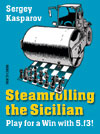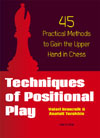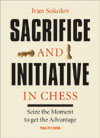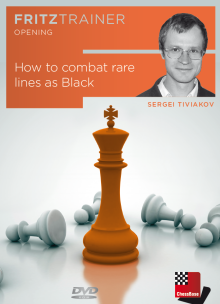Latest book
reviews of 1 November 2013
BOOKS REVIEWS BY JOHN ELBURG.
Wilhelminalaan 33
7261 BP RUURLO
The Netherlands.
CHESSBOOK REVIEWS 
Latest book reviews of 1 November 2013
BOOKS REVIEWS BY JOHN ELBURG.
Wilhelminalaan 33
7261 BP RUURLO
The Netherlands.






The
main file Tournaments is good for 206 games where a small 12 of them
are well analysed.
Impressive is the following game from Emanuel Berg with the Morra
Gambit:
Berg,Emanuel (2539) - Rocha,Sergio
(2414) [B21]
POR-chT Porto (2.1), 18.08.2013
[Berg,E]
1.e4 c5 2.d4 cxd4 3.c3!? The Morra Gambit, is that still playable?
Well, having buried it back in the days of my youth in 1992 it came as
a surprise both to me and my opponents when I revived it more than 20
years later. The unleashing came about a week before this game during
the Manhems GM-Tournament in Gothenburg where I had the delight to try
it even twice over the nine rounds. It is no secret that the book
"Mayhem in the Morra" by IM Marc Esserman bears all the guilt for my
recent reintroduction to this opening. 3...dxc3 4.Nxc3 Nc6 5.Nf3 d6
6.Bc4 a6 This is a smart move order for Black as [6...Nf6 7.e5! gives
White a good game;
while 6...e6 deprives the bishop on c8 of going to g4.] 7.0-0 Nf6
8.Bf4! [In my first encounter with this line in 2013 I played 8.h3?
preventing ...¥g4. This was obviously too slow which I also knew.
However being slightly surprised I decided just to play a practical
move. After 8...e6 9.Bf4 Be7 10.Qe2 b5 11.Bb3 Na5 12.Rfd1 Qb6 13.Bc2
Bb7 Berg,E (2539)-Hillarp Persson,T (2529) Gothenburg 2013; Black had
definitely succeeded in the opening in achieving a slight advantage.
White's activity still gives some compensation but not quite enough to
compensate for the pawn. ] 8...Bg4 9.h3 Bxf3 This is clearly the most
popular reply. [However 9...Bh5 is given as the main alternative in
Esserman's book and is also the move slightly favoured by my computer
engine.] 10.Qxf3 e6 11.Rfd1 Qc7?! This move is given as dubious by
Esserman. Indeed the queen comes quickly under attack on c7 bu it will
have to movet somewhere and White get some active counterplay in all
cases. [The other options are 11...Qb8 ;
11...Qb6;
and 11...Qa5 ] 12.Rac1 Be7 13.Bb3 Preparing to go with the knight to
d5. 13...Rc8 [After 13...0-0 the following line is given by Esserman
14.Nd5 exd5 15.exd5 Nxd5 16.Bxd5 Rac8 17.b4 This might well need a
closer look, but White certainly has good compensation for the pawn
here which the computer engine also agrees with when giving White a
slight advantage.;
13...Qb8!?N is possible but seems like a waste of time first going to
c7 and then to b8. The advantage however compared with 11...£b8
is that now Black has the bishop developed to e7 and is just a move
away from castling. White has basically won the extra tempo of ¥b3
which perhaps might not be that important. A logical continuation is
14.Na4 Trying to make use of the weak b6-square. Then Black does best
in returning with 14...Qc7 when it's up to White to find something
better than a repetition.] 14.Nd5! This is a temporary piece sacrifice
which is a common theme for the Morra Gambit as a whole. 14...exd5
15.exd5 Ne5 With this move Black hangs on to the extra piece for the
moment but will sooner or later have to give it back anyway.
16.Qe3?! A slight inaccuracy. When trying to remember the book lines I
simply forgot to consider White's optimal setup if Black decided not to
accept the piece sacrifice. [A stronger move is 16.Qg3! which puts
further pressure on Black's position. After 16...Qd7 17.Rxc8+ Qxc8
18.Bxe5 White is better placed with his pieces than in the game. The
main line follows 18...dxe5 a) In the event of 18...0-0 play is similar
to the game but better for White. Now perhaps the strongest option is
19.Bc3!?² keeping the two bishops and a stable grip on the
position.(However grabbing a pawn by 19.Bxd6 is also possible when
19...Ne4 20.Qe5 Bxd6 21.Qxe4 Re8" is better for White but should give
Black enough counterplay to maintain a draw if he defends well.) ; b)
18...Qd7 defends the pawn on d6 but is rather slow. White is doing well
after 19.Bc3 (The speculative 19.Qxg7!? is exciting but not too good
after 19...Rg8 20.Bxf6 Rxg7 21.Bxg7© when I believe White has
sufficient compensation but not more.) 19...0-0 20.Bc2² with a
stable advantage for White thanks to the active position and the strong
pair of bishops. Now lifiting the rook to d4 is an interesting idea
aiming for a straight forward attack against Black's king.; 19.d6 Bd8
20.Qxe5+ Kf8 21.d7! Qc6 22.Qb8 Qb6 23.Bc4! intending b4 and ¦d6
when White will win back the sacrificed material with a better endgame
in the worst case. Esserman gives the possible line 23...Rg8! 24.b4 Qc7
25.Qxc7 Bxc7 26.d8Q+ Bxd8 27.Rxd8+ Ke7 28.Rxg8 Nxg8 29.Kf1² when
indeed White has a pleasant endgame with good winning chances due to
the bishop being superior to the knight when there are pawns on both
wings.] 16...Qd7 17.Rxc8+ Qxc8 18.Bxe5 0-0 A good practical decision as
my opponent was getting slightly low on time while I was up till now
more or less in my preparation. [After 18...dxe5 19.d6 Bd8 (19...Bxd6
20.Rxd6 0-0 21.Qxe5 Re8 22.Qd4²) 20.Qxe5+ we are back to the line
arising after 16.£g3! 20...Kf8 21.d7 Qc6 22.Qb8 Qb6 23.Bc4! Rg8
24.b4 Qc7 25.Qxc7 Bxc7 26.d8Q+ Bxd8 27.Rxd8+ Ke7 28.Rxg8 Nxg8
29.Kf1² Esserman] 19.Bf4 This move is aimed to attack the weak d6
pawn. Now White can also join the attack with the queen to b6 at some
point. [Also interesting was 19.Bd4!?² centralising the bishop.
White keeps good control and is slightly better. ] 19...Qd7 20.Rc1 Bd8
Black is somewhat passive but remains solid.
21.Qd4 Preparing the queen manoeuvre to b4 when Black will have
problems defending both b7 and d6. 21...Re8 22.Qb4 Be7 23.Ba4 Played
after thinking far too long in a critical position. Indeed Black is now
forced to some weakening of his pawn structure but on the other hand
White loses important time for this achievement. [My original plan
23.Qb6 seems like a better option when Black needs to take care about
inviting the rook on to c7. During the game I was slightly concerned
about 23...Bf8!? when Black can get active counterplay on the kingside.
However White can play calmly by (The passive 23...Rb8 was mentioned by
Rocha. Although this defends for the moment it's extremely passive and
White has a clear advantage. Now the brave 24.g4! to control important
squares for Black is well justified after which Black will have a
difficult time defending.) 24.Be3 when after 24...Rc8 25.Rxc8 Qxc8
26.a4 Black is still under pressure without active counterplay.]
23...b5 24.Bb3 Rc8 Black simplifies the position and defends his
d6-pawn by tactical means.
25.Rxc8+ [25.Re1!? was probably a better way to play the position.
White has the more active pieces and stands slightly better.] 25...Qxc8
26.a4 [Grabbing the pawn would give Black active counterplay after
26.Bxd6 Qc1+! (Another option is 26...a5 but then 27.Qf4 a4 28.Bd1 Nxd5
29.Qe5 Qe6 30.Qxe6 fxe6 31.Bxe7 Nxe7 32.Kf1² gives White the
better prospects in the endgame.) 27.Kh2 Ne4! 28.Qxe4 (28.Bxe7 Qf4+=
leads to perpetual checks) 28...Bxd6+ 29.g3 g6 White is a pawn up, but
the opposite coloured bishops should secure a draw for Black since he
has the more active bishop and an exchange of queens will more or less
be a dead draw despite the extra pawn for White.(29...Qxb2?? loses to
30.Qe8+ Bf8 31.Kg2 Qf6 32.d6+-) ] 26...Qc5 A tricky move when
approaching time trouble.
27.Qe1 [Perhaps the endgame after 27.Qxc5 dxc5 28.d6 Bd8 29.Bd1 would
have offered better winning chances for White. However I felt that
Black's king was a bit too close and could not see any clear way to
improve my position while the d6-pawn eventually might become weak.]
27...Kf8 28.Be3 Qc7 29.axb5 axb5 30.Qb4 Qb7 31.g4 [31.Qc3!?] 31...h6
32.Qd4 [32.Qc3 Qa8 33.Kh2²] 32...Nd7 33.Qe4?! [Better was
33.Qc3!² preventing ...¥f6 due to £c6! At the same time
setting a trap as 33...Nc5 loses a pawn after 34.Bxh6! f6 (34...Nxb3??
35.Bxg7+! Kg8 36.Bh6+-) 35.Be3±] 33...Bf6! Now Black is in
control and holds an easy draw.
34.Qb4 Qa6 35.Bc2 Ne5 Now White should be slightly careful in view of
possible back rank attacks by Black's knight and queen. 36.Kg2 [36.b3
preventing ...¤c4 looks slightly risky following 36...Nf3+
37.Kg2 Nh4+ with active counterplay for Black.] 36...Nc4 37.Bc1 g5?!
[37...Qb7 38.Be4 Qb6= was to be preferred.] 38.Bd3? [A stronger attempt
was 38.b3² Qa1 39.Bxg5! hxg5 40.bxc4 bxc4 41.Qxc4² leaving
White a pawn up with some practical winning chances.] 38...Qa1 39.Bxc4
bxc4 40.Qxc4 [40.Qxd6+ Kg7 41.Be3 Qb1!= This is the simplest way
forcing a draw by perpetual checks after ...£e4 next.(41...Qxb2
42.Qc6 c3 43.d6 Qb3 44.d7 Qd1=) ] 40...Bxb2 41.Be3 Bf6 42.Qc8+ Kg7
43.Qf5 White can perhaps claim he has the better bishop but since Black
will not allow an exchange of queens this is not relevant.
43...Qc3 44.Qe4 Qb2 45.Qf5 Qc3 46.Qe4 Qb2 47.h4 A last try to
complicate matters but Black remains solid until the end. 47...gxh4
48.Qf4 Qe5 49.Qxh6+ Kg8 50.Kg1 h3 51.Qxh3 (=) ½-½.
Besides the various columns and video files there are eleven openings
reports:
Georgiev,V: Budapest Gambit A52 1.d4 Nf6 2.c4 e5 3.dxe5 Ng4 4.Lf4 Nc6
5.Nf3 Bb4+ 6.Nc3 Qe7 7.Qd5,Postny: Sicilian Kan B48 1.e4 c5
2.Nf3 e6 3.d4 cxd4 4.Nxd4 Nf6 5.Nc3 Qc7 6.Be3 a6 7.Qd2 Nf6
8.0-0-0 Be7 9.f3,Kritz: French C10 1.e4 e6 2.d4 d5
3.Nc3 a6,Breutigam: King's Gambit C34 1.e4 e5 2.f4 exf4 3.Nf3
Ne7,Pavlovic: Ruy Lopez C78 1.e4 e5 2.Nf3 Nc6 3.Bb5 a6
4.Ba4 Nf6 5.0-0 b5 6.Bb3 Bc5,Krasenkow: Ruy Lopez C84 1.e4 e5 2.Nf3 Nc6
3.Bb5 a6 4.Ba4 Nf6 5.d4,Marin: Queen's Gambit D36 1.d4 d5
2.c4 e6 3.Nf3 Nf6 4.Nc3 Nbd7,
Stohl: Grünfeld Defence D97 1.d4 Sf6 2.c4 g6 3.Nc3 d5 4.Nf3 Bg7
5.Qb3 dxc4 6.Qxc4 0-0 7.e4,Arnaudov: Tango E10 1.d4
Nf6 2.c4 e6 3.Nf3 Nc6 4.a3 d6,Schipkov: King's Indian E87 1.d4 Nf6 2.c4
g6 3.Nc3 Bg7 4.e4 d6 5.f3 0-0 6.Be3 e5 7.d5 Nh5 8.Qd2 f5 and at last
Szabo: King's Indian E97 1.d4 Nf6 2.c4 g6 3.Nc3 Bg7
4.e4 d6 5.Nf3 0-0 6.Be2 e5 7.0-0 Nc6 8.d5 Ne7 9.b4 Ne8.
Included is a eye catching booklet in to languages.
Conclusion: Super material for a
bargain price!
